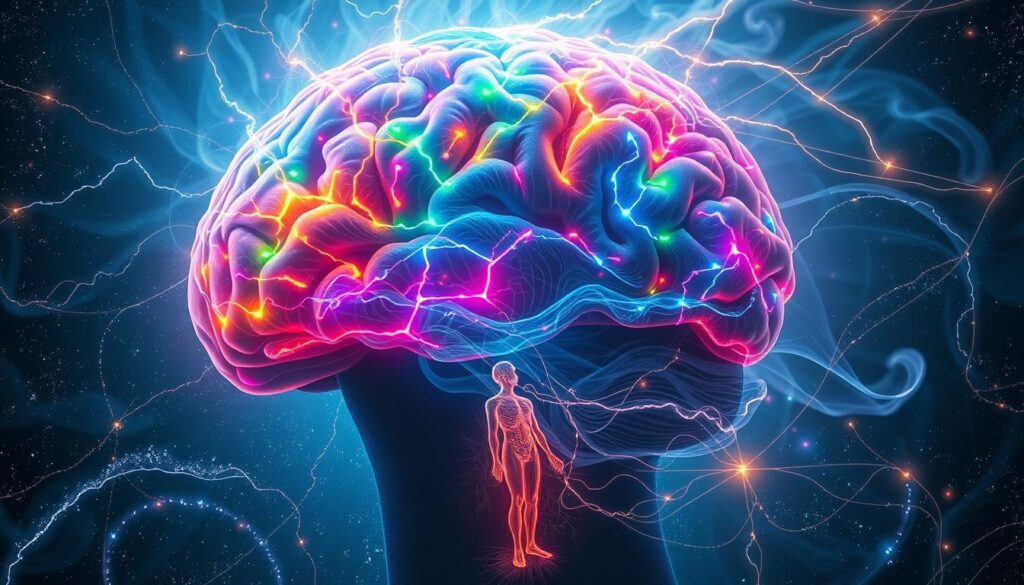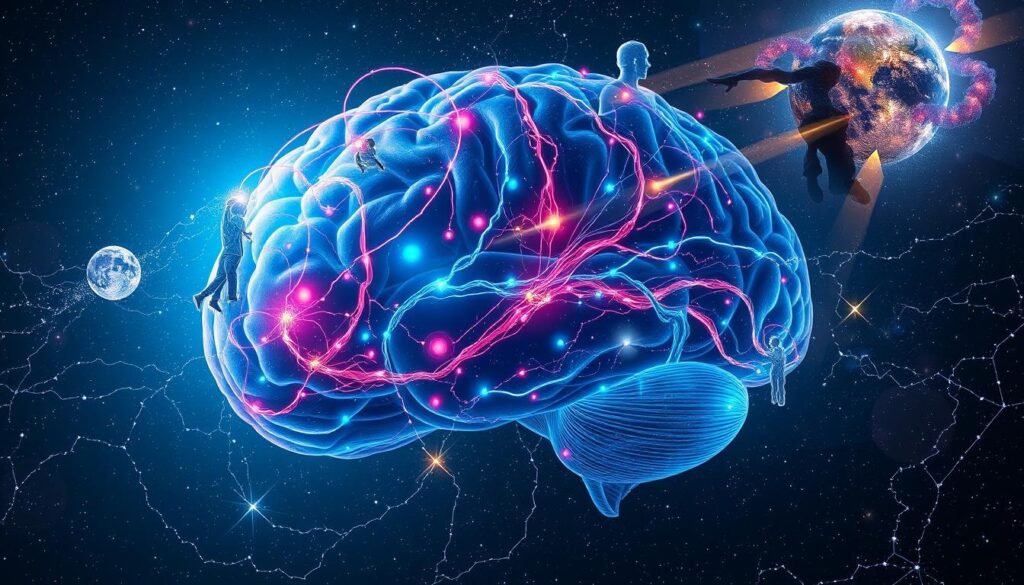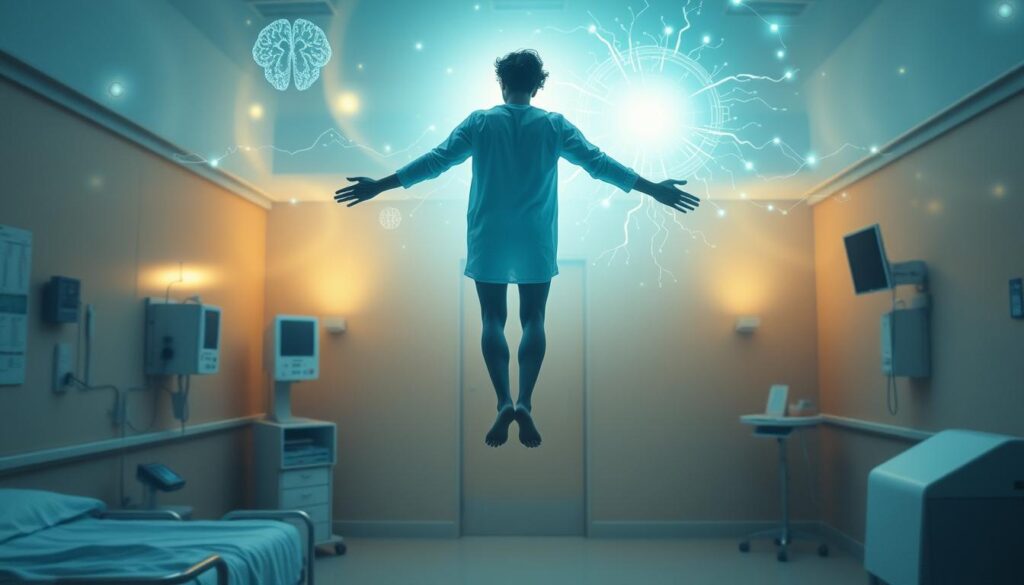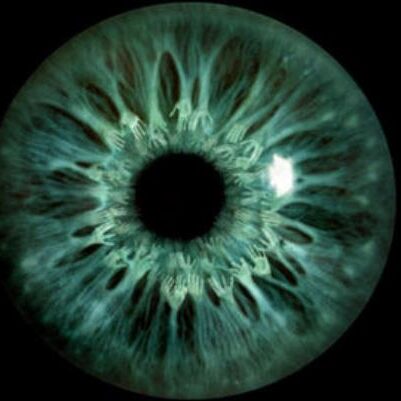Near-death experiences (NDEs) have long fascinated people. They tell of leaving their bodies, going through a dark tunnel, and meeting a bright light or spiritual beings. These experiences can change a person deeply.
Once seen as just hallucinations, science now looks into what happens in the brain during NDEs. This article will explore the latest research on NDEs. We’ll see what they tell us about consciousness and the mind-brain connection.
Key Takeaways
- Near-death experiences (NDEs) are profound, mystical experiences that occur during life-threatening situations or the dying process.
- Modern science is exploring the physiological and neurological mechanisms behind NDEs, which were once dismissed as hallucinations.
- NDEs provide insights into the nature of consciousness and the relationship between the brain and the mind.
- Researchers are using advanced neuroimaging techniques and studying brain activity during NDEs to better understand these phenomena.
- The scientific exploration of NDEs challenges conventional materialist explanations of consciousness and suggests the need for a more holistic understanding of human experience.
What are Near-Death Experiences (NDEs)?
Near-death experiences (NDEs) are deep and often life-changing events. They happen when someone is very close to death or has clinically died. These experiences occur during life-threatening situations, like heart stops or severe injuries. About 10% of people who come back from clinical death report having an NDE.
Key Characteristics and Common Elements of NDEs
NDEs often include a few common elements. People feel detached from their bodies and see themselves floating above. They might also see a dark tunnel, a bright light, or spiritual beings. These experiences are filled with a deep sense of peace and well-being.
Detachment from the Body and Out-of-Body Experiences
A big part of many NDEs is feeling like you’re outside your body. This is called an out-of-body experience (OBE). People often report seeing their own body and the area around them from a different view.
Studies show that OBEs happen with NDEs 76% of the time. A big survey found that 5.8% of people in the general population have had an OBE. This shows how common these special experiences are.
“NDEs can lead to permanent transformation in the lives of survivors.”
Historical Accounts of NDEs
Modern science started studying Near-Death Experiences (NDEs) in the 1970s. But, stories of deep experiences similar to NDEs have been around for centuries. Ernest Hemingway, famous for his writing, had a close call with death during World War I. He wrote “The Snows of Kilimanjaro,” which shows classic NDE signs like feeling detached and seeing a bright light.
Other famous people, like British admiral Sir Francis Beaufort and Scottish surgeon Sir Alexander Ogston, also shared their NDE stories. Beaufort felt calm and had quick thoughts when he almost drowned. Ogston had an out-of-body experience during a bout of typhoid fever.
“The Acts of Thomas,” an early 3rd-century New Testament text, also contains accounts of NDEs, and Saint Augustine’s book “Caring for the Dead” includes notable near-death experiences from centuries past.
These stories show that people have been fascinated by experiences beyond our world for a long time. They give us clues about what happens when we face death. These insights help us understand the deep and changing experience of a near-death encounter.

Prevalence and Causes of NDEs
Near-death experiences (NDEs) are common among many people. About 10-20% of those who come close to death and are brought back report NDEs. These experiences can also happen in other dangerous situations, like near-drowning or severe injuries.
A study of 58 people who had NDEs showed that half were not in a life-threatening situation. This suggests that feeling like you’re about to die might be more important than actually being clinically dead.
Incidence Rates in Various Populations and Scenarios
Many studies have looked into how common NDEs are. A big study in the UK, US, and Austria found that 39% of cardiac arrest survivors were aware of their surroundings. But only 9% had a full NDE, and 2% had an out-of-body experience (OBE).
Research says NDEs happen in 15% to 20% of critical patients and about 5% of everyone. This shows how widespread these experiences are.
Interestingly, NDEs are more common in women and those having their first heart attack. They are also more common in those who need more help in the hospital and have had NDEs before. However, they are less common in older people.
It’s believed that NDEs are happening more often now because of better medical care.
NDEs happen to people of all backgrounds and ages. They occur worldwide, showing that these experiences are universal and consistent.
Physiological Explanations for NDEs
Researchers have found several ways the brain might explain near-death experiences (NDEs). One important factor is syncope, or fainting. It can cause NDE-like feelings even when someone isn’t clinically dead. When someone faints, their brain gets less blood, which can make them feel like they’re outside their body.
Changes in blood flow and oxygen levels also matter. These changes can happen when someone is close to death. They might see a “bright light” or other strange things, which could be the brain’s way of trying to survive.
The Role of Syncope and Cerebral Blood Flow
Syncope, or fainting, often leads to NDE-like feelings. This is because fainting reduces blood flow to the brain. This reduction can cause feelings of being outside one’s body, similar to NDEs.
Also, changes in blood flow and oxygen levels during a crisis can shape an NDE. The “bright light” and other visuals might be the brain’s way of coping with danger.
| Key Factors in Physiological Explanations for NDEs | Description |
|---|---|
| Syncope (Fainting) | Can trigger NDE-like experiences due to temporary reduction in cerebral blood flow |
| Cerebral Blood Flow Changes | Alterations in blood flow and oxygen levels during crisis leading to clinical death may shape NDE narratives, including the “bright light” phenomenon |
| Brain’s Survival Mechanisms | Visual and other sensory experiences in NDEs may be linked to the brain’s attempts to cope with the critical situation |

These explanations help us understand NDEs better. But, NDEs are still a mystery. More research is needed to fully grasp how the brain and mystical experiences connect.
Out-of-Body Experiences (OBEs) and Their Neuroscience
Out-of-body experiences (OBEs) are fascinating events where people feel their mind has left their body. These experiences often happen when someone is near death. But, they can also happen without any danger.
Research shows that about 1 in 20 people have had an OBE. This is a common experience in the general population.
Scientists have discovered how OBEs work. They found that the temporoparietal cortex in the brain is key. This area helps the brain combine what we see, feel, and move. When this area is stimulated, it can cause OBEs.
This shows that OBEs might happen when the brain tries to make sense of mixed signals. It’s like when our senses don’t agree on what’s happening.
People who have OBEs often feel like they are floating above their body. They see their body from above. Many things can trigger OBEs, like brain issues, certain drugs, or anesthesia.
“55% of individuals who had an out-of-body experience reported that the experience profoundly changed their lives, and 71% described the out-of-body experience as having a lasting benefit.”
OBEs can make people more caring and understanding. They can lead to more empathy and peaceful relationships. Learning about OBEs helps us understand our minds and bodies better. This knowledge is important for treating mental health issues.

Near-death experiences: what science says
Near-death experiences (NDEs) have sparked debates about the soul and consciousness. Some scientists think these experiences can be explained by the brain’s survival mechanisms. They believe the brain’s way of processing information during crisis can cause the vivid sensations and insights reported by NDE experiencers.
This perspective suggests NDEs are meaningful but don’t need a supernatural explanation. The complex brain processes during a life-threatening event might be behind the experiences.
Bridging the Gap Between NDEs and Neuroscience
Dr. Bruce Greyson has spent his career studying the mind and brain. He has looked at over 1,000 NDE cases, challenging our understanding of consciousness and its link to the body.
Greyson developed the Final NDE Scale to assess NDE components. This tool has helped researchers understand the common traits of NDEs. It has also shed light on the mechanisms behind these experiences.
With better survival rates in life-threatening situations, more NDEs are being reported. This allows for deeper scientific study. Improved resuscitation techniques have made it easier to study NDEs in a clinical setting.

By studying NDEs through neuroscience, researchers aim to understand the brain and consciousness better. They want to explore how the brain and consciousness interact. This could help us grasp the mysteries of the mind.
The Mystical Sense of Oneness and Its Connection to NDEs
Near-death experiences (NDEs) often bring a deep sense of unity with the universe. This feeling is a key part of mystical experiences. It’s linked to serotonin-2a receptors in the brain’s limbic system. This area handles emotions and spiritual experiences.
The Role of Serotonin-2a Receptors and the Limbic System
Studies show that blocking serotonin-2a receptors or removing parts of the limbic system can affect this unity. It shows how brain processes shape the mystical parts of NDEs. This is a key finding in understanding these extraordinary experiences.
| Key Findings | Implications |
|---|---|
| Blocking serotonin-2a receptors disrupts the mystical sense of oneness | Suggests a neurobiological basis for the mystical aspects of NDEs |
| Removing parts of the limbic system disrupts the mystical sense of oneness | Implicates the limbic system’s role in mediating spiritual experiences |
These discoveries show how brain chemistry and structure relate to deep experiences in NDEs. By studying these neural mechanisms, researchers can learn more about consciousness and our experience of the mystical.
The Brain’s Survival Mechanisms and NDEs
When the brain is in crisis, like when blood flow drops, it starts survival actions. These include the fight-or-flight response from the ancient limbic system. Experts think that near-death experiences (NDEs) might be the brain’s way to cope with danger. They believe NDEs help the brain keep the person alive, even if they don’t make it.
NDEs have become more common, possibly because of better medical care. Research shows that women, first-time heart attack victims, and those needing more hospital care are more likely to have NDEs. NDEs happen all over the world, showing no cultural or time differences.
Scientists have many theories about NDEs, like brain chemistry changes or retinal issues. Some think NDEs are just our minds playing tricks when we’re in danger. While some studies help understand NDEs, the exact brain mechanisms are still a mystery.
“The incidence of Near-Death Experiences (NDEs) can be estimated between 15% and 20% of critical patients and around 5% of the general population.”
In the U.S., about nine million people have had a near-death experience, a 2011 study found. Kenneth Ring discovered that NDEs from attempted suicides are just as common as others. Bruce Greyson’s scale for NDEs includes feelings of time slowing down, peace, and unity with the universe.
Reconciling NDEs with Modern Neuroscience
The scientific world is still debating near-death experiences (NDEs). Some say these experiences can be explained by modern neuroscience. They believe NDEs are just the brain’s way of coping during emergencies. Others think NDEs show us something beyond the physical world, hinting at the existence of a soul or consciousness.
The Debate: NDEs as Brain Phenomena or Transcendental Experiences
The mystery of consciousness and the brain’s role is at the heart of this debate. The REM intrusion hypothesis suggests NDEs come from a shift in brain activity, causing out-of-body feelings. Yet, others believe NDEs prove there’s more to life than what we can see and touch.
Both sides have their evidence, but the brain’s complexity makes it hard to agree. As scientists keep studying, they might find answers that bring these views closer together.
“Factors predisposing a person to reporting NDEs may include cognitive style, personality, subclinical epileptic signs, vascular distribution anomalies, and increased sensitivity to stress hormones.”
So, the quest to understand NDEs in terms of neuroscience is still a challenge. It shows how much we still don’t know about our minds and consciousness.
Personal Accounts of NDEs by Medical Professionals
Many medical professionals have shared their near-death experiences (NDEs). These stories come from doctors and researchers who usually look at things scientifically. Their accounts add credibility to the reality of NDEs.
These personal stories give us a new view on NDEs. They show how these experiences can change a person’s life. They challenge what we think we know about the mind and reality.
“I was a skeptic before my own NDE, but now I can say with certainty that there is more to consciousness than what we can measure with our current scientific tools. My experience was profoundly life-changing, and it has given me a deeper appreciation for the mysteries of the universe.”
– Dr. Sarah Williamson, Emergency Physician
Medical professionals’ NDE stories are special. They come from people who usually question things. Their experiences remind us that NDEs are real and can deeply change a person.
| Statistic | Value |
|---|---|
| Estimated number of people in the US who have reported an NDE | 9 million |
| Percentage of cardiac arrest survivors who report having an NDE | 10 to 23 percent |
| Percentage of individuals who have experienced an NDE and also reported REM sleep intrusion | 47 percent |
| Percentage of individuals who have not experienced an NDE but reported REM sleep intrusion | 14 percent |
Medical professionals’ NDE stories are unique and valuable. They show us that NDEs are real and can deeply change a person. These stories remind us that NDEs are not just ideas, but real experiences that can last a lifetime.
Recognizing and Understanding NDEs in Clinical Practice
Near-death experiences (NDEs) are becoming more common. It’s important for doctors to be sensitive and open when dealing with them. Patients who have had an NDE often want to talk about it. Doctors should listen and offer support.
Ignoring or not validating these experiences can make patients feel alone and confused. By understanding NDEs and discussing them, doctors can help patients make sense of these life-changing events.
The Importance of Physician Sensitivity and Openness
Studies show that up to 15% of patients who survive cardiac arrest have had an NDE. These experiences can deeply affect a person’s life, beliefs, and outlook. Recognizing NDEs in clinical practice and understanding NDEs is key for physician sensitivity and caring for patients.
By openly discussing NDEs and validating the patient’s experience, doctors can help patients integrate these experiences into their lives.
“The more open and sensitive physicians are to understanding near-death experiences, the better they can support their patients in processing and making sense of these profound, life-changing events.”
Knowing about NDEs can strengthen the bond between doctors and patients. Patients who feel heard and understood are more likely to trust their healthcare team. This can improve the quality of care and help in recovery.
Creating an open and understanding environment is crucial. Healthcare providers play a key role in helping patients deal with the emotional and spiritual aspects of NDEs. This approach benefits not just the patient but also the medical community and society as a whole.
The Ongoing Mystery of NDEs
Despite a lot of research, near-death experiences (NDEs) still puzzle us. Some think they’re just brain activity, while others see them as signs of something beyond our minds. This debate is likely to keep going for a while.
Scientists are studying NDEs to understand what happens in our brains and bodies. But they also know there’s a lot they don’t get yet. New discoveries in neuroscience have helped us understand some parts of NDEs, but there’s still a lot to learn.
Acknowledging the Limitations of Current Understanding
Studies show that 10% to 20% of people who come back from near death have NDEs. Also, about one in 10 people say they’ve had an NDE due to heart problems. This means around 800 million people might have had such experiences.
Raymond Moody’s book “Life After Life” helped make NDEs famous. It was based on 150 stories of intense experiences during cardiac arrest. Yet, as we keep studying, we might find that NDEs show us something deep about our consciousness that science doesn’t fully understand yet.
“The more we learn about near-death experiences, the more we realize how little we truly understand about the nature of consciousness and its relationship to the physical world.”
As technology improves and different fields work together, we might solve the mystery of NDEs. But for now, scientists must admit they don’t know everything. They should be open to new ideas that challenge what we think we know.
Conclusion
Near-death experiences have caught the public’s eye and sparked a lot of scientific interest. Some say these experiences fit into what we know about the brain. But others think they show that our consciousness or soul might exist outside our bodies. The mystery of NDEs raises big questions about our minds and bodies.
As scientists delve deeper into NDEs, it’s key for healthcare workers and everyone else to be open and caring. The key takeaways from this article show NDEs might be a special state of awareness. This could change how we see the brain, mind, and what happens after we die.
More research is needed to really get to the bottom of NDEs. But, the evidence and stories from people who’ve had NDEs are growing. By being open and curious, we might learn a lot about our consciousness and the world around us.
FAQ
What are near-death experiences (NDEs)?
Near-death experiences (NDEs) are deep, mystical events. They happen to people who almost die, like during heart stops or severe injuries. People often feel out of their body, see a tunnel, and meet a bright light. They also feel deep peace and happiness.
What is the prevalence and causes of NDEs?
About 10-20% of people who come back from clinical death have NDEs. But, NDEs can also happen in other life-threatening situations, like drowning or fainting.
What are the physiological explanations for NDEs?
Scientists think that NDEs might be caused by fainting or changes in blood flow and oxygen in the brain. These changes could explain the “bright light” and other visuals in NDEs.
What is the relationship between out-of-body experiences (OBEs) and NDEs?
OBEs, where you feel your mind is outside your body, are common in NDEs. But, OBEs can also happen without near-death experiences. Research shows that the brain’s special area can make you feel like you’re out of your body.
How do researchers reconcile NDEs within the conventional neuroscience framework?
Some scientists think NDEs can be explained by the brain’s survival tricks. They believe the brain’s way of handling crisis and low blood flow can cause NDEs. This means NDEs might not need supernatural explanations.
What is the role of the “mystical sense of oneness” in NDEs?
The feeling of being one with everything in NDEs is linked to brain chemistry. It involves serotonin, which affects emotions and spiritual feelings. Blocking serotonin can change this feeling in NDEs.
How do the brain’s survival mechanisms relate to NDEs?
Researchers think NDEs might help the brain cope with danger. The brain’s efforts to survive could explain the peace and sense of detachment in NDEs. It’s like the brain’s way to keep consciousness alive during a crisis.
What is the debate surrounding the interpretation of NDEs?
Scientists are still arguing about what NDEs mean. Some say they can be explained by brain science, while others believe they show the existence of a soul or consciousness beyond the brain. This debate shows how mysterious consciousness and the mind-brain connection are.
How do personal accounts of NDEs by medical professionals contribute to the understanding of this phenomenon?
Doctors and researchers who’ve had NDEs share their stories. Their accounts help show that NDEs are real. They add credibility to these experiences.
How can healthcare providers recognize and understand NDEs in clinical practice?
Healthcare workers should know about NDEs and be open to talking about them. Patients who’ve had NDEs might want to share their experiences. Doctors should listen and offer support. Ignoring these experiences can make patients feel alone and confused.
Source Links
- Can Science Explain Near Death Experiences? – https://www.discovermagazine.com/mind/can-science-explain-near-death-experiences
- The science of near-death experiences – https://www.vox.com/the-gray-area/351128/the-science-of-near-death-experiences
- What is a near-death experience? – https://www.polytechnique-insights.com/en/columns/health-and-biotech/what-is-a-near-death-experience/
- What Near-Death Experiences Reveal about the Brain – https://www.scientificamerican.com/article/what-near-death-experiences-reveal-about-the-brain/
- Near-Death Experiences: Neuroscience Perspectives on Near-Death Experiences – https://www.ncbi.nlm.nih.gov/pmc/articles/PMC6170042/
- The Science of Near-Death Experiences – https://www.ncbi.nlm.nih.gov/pmc/articles/PMC6139799/
- Near-Death Experiences Evidence for Their Reality – https://www.ncbi.nlm.nih.gov/pmc/articles/PMC6172100/
- The Science of Near-Death Experiences – https://www.theatlantic.com/magazine/archive/2015/04/the-science-of-near-death-experiences/386231/
- Ten of the Earliest Recorded Near-Death Experiences – Listverse – https://listverse.com/2023/03/23/ten-of-the-earliest-recorded-near-death-experiences/
- World’s largest near death experiences study – https://www.southampton.ac.uk/news/2014/10/07-worlds-largest-near-death-experiences-study.page
- Frontiers | Near-death experiences between science and prejudice – https://www.frontiersin.org/journals/human-neuroscience/articles/10.3389/fnhum.2012.00209/full
- One in 10 people have ‘near-death’ experiences, according to new study – https://www.eurekalert.org/news-releases/894649
- Explanation of near-death experiences: a systematic analysis of case reports and qualitative research – https://www.ncbi.nlm.nih.gov/pmc/articles/PMC10158795/
- Frontiers | Explanation of near-death experiences: a systematic analysis of case reports and qualitative research – https://www.frontiersin.org/journals/psychology/articles/10.3389/fpsyg.2023.1048929/full
- Ch23-P374168.indd – https://www.epfl.ch/labs/lnco/wp-content/uploads/2018/08/2009_Blanke_TNCchap_leaving-body-and-life-behind-obe-and-nde.pdf
- Neuro-functional modeling of near-death experiences in contexts of altered states of consciousness – https://www.ncbi.nlm.nih.gov/pmc/articles/PMC9891231/
- "Out-of-Body Experiences” Can Lead to Profound and Lasting Psychological Transformations, New Research Reports – The Debrief – https://thedebrief.org/out-of-body-experiences-can-lead-to-profound-and-lasting-psychological-transformations-new-research-reports/
- Near-death experience – https://en.wikipedia.org/wiki/Near-death_experience
- Near-Death Experiences – Division of Perceptual Studies – https://med.virginia.edu/perceptual-studies/our-research/near-death-experiences-ndes/
- Near-Death Experiences, Psychedelics, Human Consciousness – https://www.nyas.org/ideas-insights/blog/what-near-death-and-psychedelic-experiences-reveal-about-human-consciousness/
- Polkinghorne pages M99 – https://med.virginia.edu/perceptual-studies/wp-content/uploads/sites/360/2017/01/NDE46_spirituality-Zygon.pdf
- Near-Death Experiences The Last Word – https://www.ncbi.nlm.nih.gov/pmc/articles/PMC6170063/
- What Really Happens to Your Brain When You Almost Die – https://www.scientificamerican.com/article/lifting-the-veil-on-near-death-experiences/
- The Neurology Of Near-Death Experiences – ImagineMD – https://imaginemd.com/blog/the-neurology-of-near-death-experiences/
- Western Scientific Approaches to Near-Death Experiences – https://www.mdpi.com/2076-0787/4/4/775
- Modern neuroscience and near-death experiences: Expectancies and implications. comments on “A neurobiological model for near-death experiences” – https://www.newdualism.org/nde-papers/Persinger/Persinger-Journal of Near-Death Studies_1989-7-233-239.pdf
- 5 Credible Stories of Near-Death Experiences (Peer-Reviewed) – https://www.magiscenter.com/blog/credible-near-death-experience-stories
- The new science of death: ‘There’s something happening in the brain that makes no sense’ – https://www.theguardian.com/society/2024/apr/02/new-science-of-death-brain-activity-consciousness-near-death-experience
- Decoding The Mystery Of Near-Death Experiences – https://www.npr.org/2009/05/22/104397005/decoding-the-mystery-of-near-death-experiences
- Life after death? Study reveals near-death experiences are not hallucinations – https://studyfinds.org/near-death-experiences/
- Near-death experiences are ‘electrical surge in dying brain’ – https://www.bbc.com/news/science-environment-23672150
- New Near-Death Experience Science Suggests an Afterlife | The Examiner News – https://www.theexaminernews.com/new-near-death-experience-science-suggests-an-afterlife/

